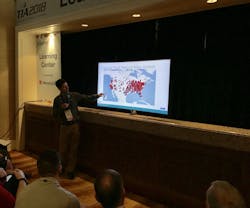PALM DESERT, CA. With capacity still as tight as almost any time in history, freight brokers meeting here sought ways to leverage technology to improve efficiency and better connect truckers with shippers.
A common theme was providing truckers more transparent rate information, and to focus on customizing the freight-matching process ahead of a likely economic cool down next year.
At its core, truckers still want to know how to “get me home and get me paid,” Trent Broberg, vice president of customer success for Truckstop.com, said at the Transportation Intermediaries Association annual conference and exhibition.
He told conference attendees there is an opportunity to win more business by offering quick-pay programs that shrink 45-day pay windows to less than one day.
Brent Hutto, chief commercial officer at Truckstop.com, said shipments move quicker when the rates are available online. “Transparency of information will move your freight faster,” Hutto said, noting that loads posted with rates are claimed at least four times faster than those with no rate information provided.
While there still is often a short negotiation process to close the deal, greater transparency yields faster transactions, he added.
Alex Perry, data analytics consultant with DAT Solutions, also said offering up-front rate information results in faster load acceptance. He noted there continues to be a major imbalance of loads-to-trucks, even in dry vans, since many carriers have been able to find enough loads without posting.
However, he said these same carriers are often searching online load boards, such as DAT. Understanding not only who is posting but also who is searching can help brokers better connect compatible carriers with shippers in the future as capacity loosens, Perry said.
Hutto also said there is a greater need to provide a customized experience by knowing preferred routes and what equipment they are using.
In addition, the better a company understands how long a trucker is willing to stay out on the road and the ideal length of haul, the better connection brokers can make, he said.
Damon Langley, a director with TMW Systems, said there is not as much a driver shortage as “driver misusage.”
Langley blamed shortfalls in the appointment process for scheduling pick-ups and deliveries, which is leading to excessive detention times. That is wasting the equivalent of 50,000 trucks from the marketplace.
“That is the truth - we need to fix that,” he said.
Trucks, on average, are only being utilized less than 7 hours a day, translating into countless lost business. “Hundreds of hours a day are wasted. It is real money,” Langley said.
Meanwhile, Noel Perry, chief economist for Truckstop.com, said even if the current environment may be the best-ever for brokers, they should exercise some caution because changes are on the horizon.
He predicted spot market prices on a month-over-month basis will be flat by the end of the year, and spot and contract rates will by lower by the end of 2019 than they are today.
“Now is the time to be worried about next year,” Perry said.
The increasing flow of real-time information can make planning for the future a bit easier, he said. For example, data can provide detailed information about how certain lanes perform on different days of the week so “you can understand what they market will be like on the day you will be there.”
TMW’s Langley also said carriers who have provided pay raises to keep drivers in this hot market should be thinking now how they will handle finances when “rates comes back down.”
Mark Montague, senior analyst with DAT, said there is no indication of any immediate economic slowdown.
However, he said spot market headhaul rates appear to have peaked and that volumes for February and March were slightly below the same months in 2017.
About the Author
Neil Abt
Neil Abt is a former FleetOwner editor who wrote for the publication from 2017 to 2020. He was editorial director from 2018 to 2020.
